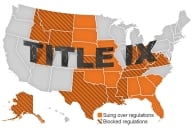You have /5 articles left.
Sign up for a free account or log in.
Admissions offers to and applications from prospective international students continue to increase at graduate schools in the United States, although the rate of growth has slowed, according to a report from the Council of Graduate Schools released today.
The number of offers of admission to international students increased by 4 percent from 2007 to 2008, compared to gains of 8 and 12 percent, respectively, in the preceding two years.
Meanwhile, applications from international students rose 6 percent in 2008, compared to 9 percent in 2007. Among the 49 graduate schools that responded to the survey in both 2004 (the baseline year) and 2008, 60 percent report fewer international applicants now than then.
In total, 177 graduate schools -- including all 10 of the top 10 in terms of international graduate student enrollment size, and 74 percent of the top 50 -- responded to the survey, for a 37 percent response rate.
Speaking of the slowdown, "You could say, ‘Well, we had this real growth spurt in the late '90s and early 2000s,’ which indeed we did. But my general take on our numbers is really as follows: It’s a good thing that we’re continuing to see growth both in applications and admissions, but given the fact that the world pool is expanding dramatically, it would be a mistake to ignore this trend line of a slowdown in growth,” said Debra W. Stewart, the council's president.
“We already can’t admit everyone who applies, so the real question is, ‘Are we still getting a good, strong number of high-quality applicants?’ We’re not getting information to suggest that we’re not. On the other hand, at some point, there is a relationship between applications and quality. And we don’t know the point at which that would be reached, because for the last several decades we’ve just had a surplus of applicants. But the world has simply gotten more competitive.”
Stewart said that many graduate schools are seeking to enhance their own global competitiveness by developing dual and joint degree or certificate programs with overseas institutions, most commonly with universities in Europe. The survey found that 38 percent of graduate schools have at least one such program, up from 29 percent in 2007. Meanwhile, 31 percent of institutions indicate plans to establish a new collaborative program within the next two years.
In terms of international student applicants and admits, the report cites "increasingly fierce competition" from Europe, as well as intensified efforts in China, India, Japan and South Korea (the top four sending countries) to keep more students at home while also recruiting more from abroad. In 2007, admissions offers to Indian students grew 17 percent, compared to 2 percent growth in 2008. Admissions from South Korea decreased 3 percent in 2008, following a 2 percent decline the previous year.
Admissions offers for Middle Eastern students did, however, grow more this year than last: up 17 percent in 2008, after a 12 percent climb in 2007.
| Country or Region of Origin | % Change in Applications, 2006-7 | % Change in Applications, 2007-8 | % Change in Admissions Offers, 2006-7 | % Change in Admissions Offers, 2007-8 |
| China | 19 | 11 | 24 | 16 |
| India | 12 | 2 | 17 | 2 |
| South Korea | 0 | 2 | -2 | -3 |
| Middle East | 17 | 14 | 12 | 17 |
The report also notes that overall trends can mask differences between small and large institutions. International admissions offers, for example, rose 8 percent at the 10 institutions with the largest international graduate student enrollments, compared to 1 percent at institutions outside the top 50.
Below is a chart showing changes in international application and admissions trends at U.S. graduate schools by discipline.
| Field | % Change in Applications, 2006-7 | % Change in Applications, 2007-8 | % Change in Admissions Offers, 2006-7 | % Change in Admissions Offers, 2007-8 |
| Business | 15% | 10% | 10% | 2% |
| Education | 12 | -1 | 11 | -13 |
| Engineering | 13 | 4 | 16 | 4 |
| Humanities and the Arts | 8 | 7 | 10 | 4 |
| Life Sciences | 18 | 3 | 11 | -1 |
| Physical Sciences | 12 | 7 | 8 | 13 |
| Social Sciences | 0 | 9 | 4 | 4 |
Source: Council of Graduate Schools








